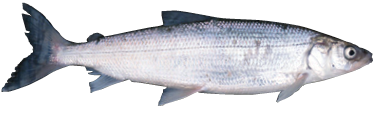ALSO KNOWN AS
- whitefish (common)
- adikamig (Anishinaabe)
- Coregonus clupeaformis (science)
TASTE AND NUTRITION
Lake whitefish has a delicate, mild flavor. It’s a solid choice for people who aren’t keen on eating food that tastes “fishy.” The flesh is medium-firm with a large flake. Lake whitefish has higher levels of heart-healthy omega-3 fatty acids (EPA and DHA) than Atlantic cod. The meat tends to be firmer and fattier in colder weather.
HOW THEY ARE HARVESTED
In Wisconsin, lake whitefish are harvested from Lake Michigan and Lake Superior primarily with trap nets and, to a lesser extent, gillnets. Commercial fishers from Michigan, Ohio and Canada also harvest lake whitefish from the Great Lakes.
CONSUMPTION ADVICE
- Lake Superior: 1 lake whitefish meal per week.
- Lake Michigan: 1 lake whitefish meal per month.
If you are unsure of the origin of the whitefish, follow the most restrictive recommendation (once a month). For details, see Wisconsin Department of Natural Resources: Eating Your Catch.

